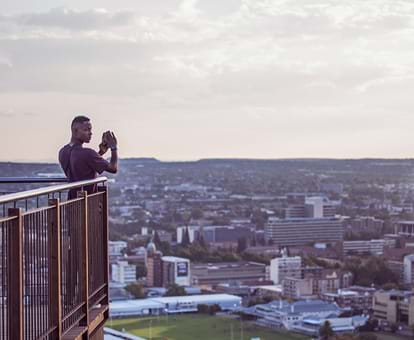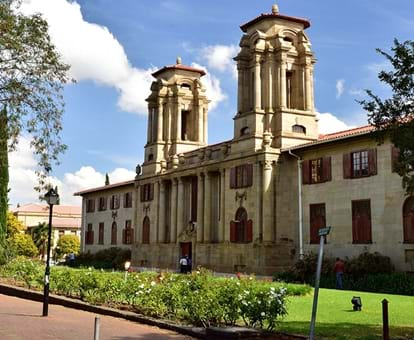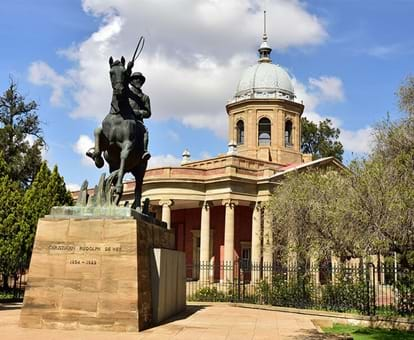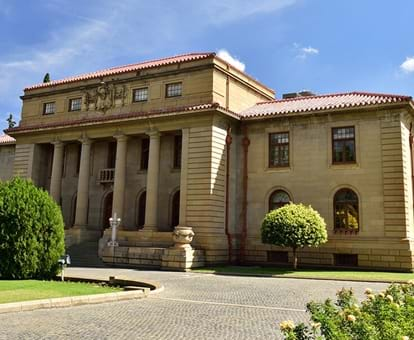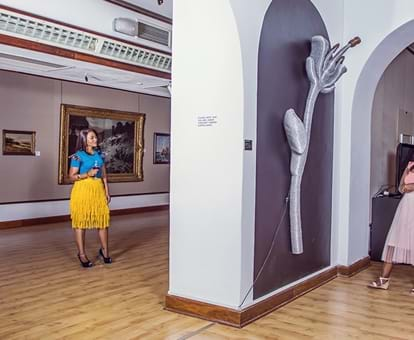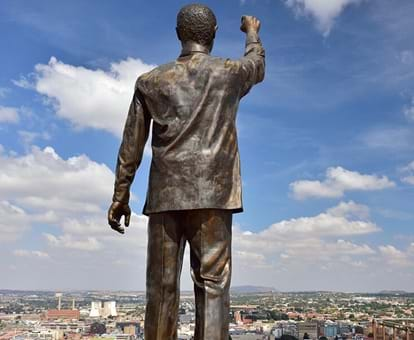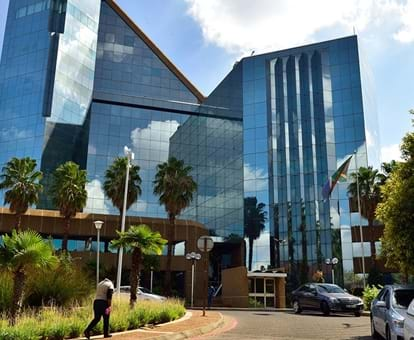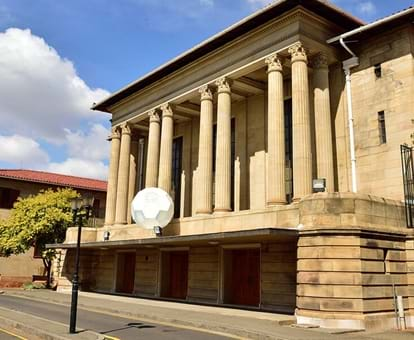By creating an account, I agree to the
Terms of service and Privacy policy
Choose your country and language:
Africa
Americas
Asia Pacific
Europe
SSitting on the stoep (verandah) of your Bloemfontein guesthouse sipping a beer or a glass of wine…what now? As a visitor to the City of Roses, founded in 1846, and in the heart of central South Africa, you’ll have a wide variety of places to visit.
Among these is the National Museum in Aliwal Street, acclaimed for the excellent way it’s been maintained since 1915, and for its outstanding natural and cultural heritage exhibitions. You cannot miss the Oliewenhuis Art Museum, with its wonderful art treasures, housed in the former imposing state presidents’ residence. The underground gallery at this museum, the Reservoir - possibly the only one of its kind in South Africa - is quite an experience. This huge underground water storage structure, built in approximately 1904, was discovered by chance in the grounds of Oliewenhuis in the 1990s. With considerable effort the endless structural problems were overcome and it was converted into a large exhibition hall.
If you have the opportunity, do slip into the Freshford House Museum. The house, which represents the more affluent middle class (the first owner, John Harrison, was a well-known architect in the town), is a unique example of the late Republican Free State architecture with the striking elements of the late Victorian/Edwardian transitional period.
TThe War Museum of the Boer Republics is the only museum in the world that represents the heartrending Anglo-Boer War (1899-1902), which led to the loss of the independence of the two Boer Republics in South Africa. The displays here are poignant and tend to disturb and shock the visitor. Also on the premises is the National Women’s Memorial, which commemorates the death of more than 26 000 women and children in the concentration camps during the war.
Bloemfontein is and remains the founding city of two of the country’s largest political parties of all time, both of which had a tremendous influence on the course of history in South Africa - the African National Congress as the party of liberation, and the National Party as the apartheid and governing party from 1948 until 1994. Both buildings where these parties were founded, the former in the Wesleyan Church School building (1904), Fort Street, in 1912 and the latter in the Ramblers Club building (original 1897), Aliwal Street, in 1914, were restored to their former glory.
Visible above the Church School on the kopje is the Queen’s Fort Military Museum. The fort dates back to 1849 and the displays represent the military activities in which people of the Free State were involved until 1994.
Drive on to the well-known double-storey red brick Mapikela House (1926), a declared World Heritage site, in Batho township and grasp the fact that one of the great campaigners of the struggle and founder member of the ANC, Thomas Mapikela (1869-1945), lived in this house.
SStill keen to experience struggle history? Do remember that Bloemfontein was the “home town” of the enigmatic and world famous struggle activist – from the ranks of Afrikanerdom - Advocate Bram Fischer (1908-1975) of Johannesburg. He was born in Bloemfontein, grew up there, and attended school and university there… and then came back to the city to die. The beautiful restored home at 72 Reitz Avenue, Westdene, known as “Harmonie”, was Bram’s parents’ home and is a declared Heritage Site. (There’s a Bram Fischer Route Map available for tourists).
Keen on walking? Find the Route Map that reads “Let’s do a rose-walk in Bloemfontein to experience the past and the present”. This route concentrates primarily on the core from which the city developed and Pres. Brand Street is the most impressive section of this route. The tree-lined street is a declared Conservation Area which, because of its unique, mostly official, historical sandstone buildings, tends to kindle in one a feeling of nostalgia for bygone days.
At the southern end, if that is where you have begun, you’ll start at the dignified Old Presidency, home of the last three state presidents of the Orange Free State Republic and presently a museum. Walk a little further past the stately high court (1906) and the fire station (1933) - the city also has its own Fire Brigade Museum in which no fewer than 18 vintage fire engines stand resplendent – and see the beautiful old Government Building (original 1875) in which the National Afrikaanse & Sesotho Literary Museum is housed today. Now move on past the imposing Fourth Raadsaal which, since its inception, has served as “parliament” (today as provincial legislature) in the Free State and then past the striking equestrian statue of the illustrious Boer General CR de Wet. Directly opposite is the country’s Appeal Court (1929). Then there is the town hall, the cornerstone of which was laid in 1934 by Prince George of Great Britain.
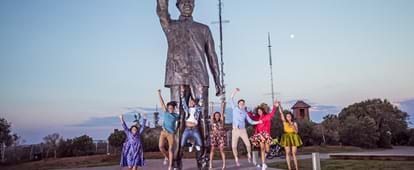
DDiagonally opposite the Old Presidency in St George Street, you’ll find the First Raadsaal Museum with its white-washed walls, the oldest preserved building in the city representing pioneer architecture which, in 1849, started as a little school, then served as “parliament” and later, with extensions, became the beginning of the National Museum in 1877. Directly behind this museum is the Wagon Museum, housing antique wagons and vehicles.
Last, but not least, a visit to Naval Hill – the “mountain” in the heart of the city , and with its Franklin Game Reserve, is one of the most sought-after tourist attractions. Here you can also visit the impressive Mandela statue, from which there is a magnificent view over the city, and the new Naval Hill Planetarium which is integrated with the old Lamont-Hussey Observatory.
Information about most of the places of interest mentioned is available at the tourist office (Mangaung Tourism) in Park Road, as well as at the various museums. Look for a map on the “Tolkien Route”. Yes, the highly respected J.R.R. Tolkien of Lord of the Rings fame was born in Bloemfontein in 1892 and lived there as a toddler before he left with his mother for England. Young Tolkien was baptised in the Anglican cathedral in Bloemfontein.
Enjoy Bloemfontein! You will not regret a visit… the friendly city beckons!

AAbout the author
Hannes (Johannes) Haasbroek was born in Bothaville in the Free State and completed his schooling in Bethlehem. He obtained a D Phil in history in 1986 from the University of the Free State, and in 1979 was appointed as a historian and head of the history department of the National Museum, where he still works. He has published many historical articles in scientific journals, magazines and newspapers, many of them with a Bloemfontein/Mangaung or Free State history connection. In 2002 his discovery of the founding place of the ANC in Bloemfontein reached national headlines. His books include Stem en Legend, ‘n Seun Soos Bram - ‘n Portret van Bram Fischer en sy Ma Ella, Splinters en Dorings uit die Rosestad se Verlede, Spikkels en spatsels uit Bloemfontein se verlede, and Woudfontein. In 2012 he received the prestigious SALA (South African Literature Awards) prize for creative non-fiction for ‘n Seun Soos Bram, and he was also nominated for the annual “Bloemfonteiner of the Year” contest.
Related articles

|Terms and conditions|Disclaimer|Privacy policy|Terms and Conditions-Valentines Campaign
